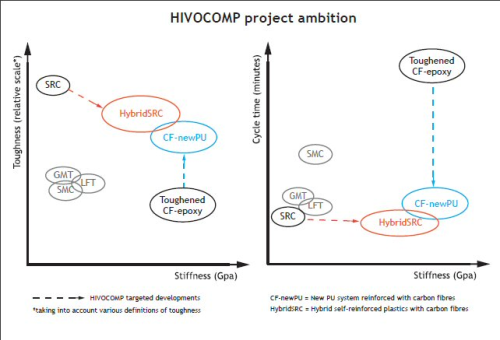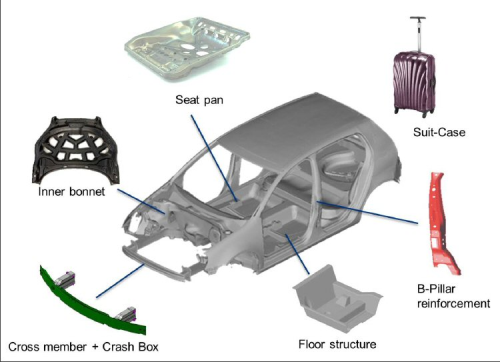

Environmental concerns related to road transportation have urged most regions in the world to introduce legislation on carbon dioxide (CO2) emissions. Research and development on a global scale has therefore been focused on alternative power trains and lighter vehicles.
There is no doubt that in the wake of the lightweighting efforts, metals are challenged as the main structural material in cars. In spite of new developments in high-strength steel, aluminium and magnesium, composites have gained staggering interest from the automotive industry. For composites to make a real impact in the automotive industry, technical advancements need to go hand-in-hand with the reconfiguration of existing supply chains and competence profiles in the industry.
Opportunities and challenges
Carbon fibre based composites have an exceptional potential for weight reduction. They have proven their capacity for weight reduction in the new generation of commercial airplanes, where over 50% composites are today a reality. Composites have furthermore given new design opportunities.
The aerospace industry has undertaken a serious and thorough development process over many years, and stands today at a point where carbon fibre composites represent a cost-effective solution. This has come about as a result of decades of heavy investment in research and development.
When it comes to the automotive industry, it is more of a dual-speed process, in terms of both production volumes and application profiles. Part substitution in semi-structural applications has happened at a relatively rapid pace and this has often been possible because of the moderate structural demands. Carbon fibres were not the only choice, glass fibres (for body panels, bumpers, etc.) and even natural fibres for interior parts, have also been used. Fast implementation and large volumes have been achieved.
On the other hand, fully-fledged metal replacement in highly demanding structural applications in high volume cars is still coming up against the early obstacles in the maturation process. For such applications, carbon fibres are the preferred option. Issues such as design and use experience, supply chain capacity, and a widespread competence base among the value-chain partners is still not fully developed.
| If carbon fibre composites are to earn a position based on environmental arguments and CO2 reduction at a global scale, they need to go beyond extreme and expensive cars. They have to reach the mass market, ... |
If carbon fibre composites are to earn a position based on environmental arguments and CO2 reduction at a global scale, they need to go beyond extreme and expensive cars. They have to reach the mass market, which requires material and process systems to be developed for high volume manufacturing and fulfill both cost and environmental requirements on a full life cycle basis.
The automotive approach
The composite industry is approaching these opportunities from two sides.
One approach is to streamline the so-called ‘advanced composite’ technologies and processing routes to suit high production rates. This has its origin in many years of solid development, primarily by the aerospace industry. New preform systems as well as new, faster curing resins have entered the market, all aimed at high volume production. Out-of-autoclave curing and different types of resin transfer moulding (RTM) techniques are increasingly used in the automotive industry, and also for carbon fibre composite structural parts. However, their cost effectiveness remains to be proven in terms of both investment and product costs.
The other approach is to adapt engineering composites by using new fibre and preform systems, leading to improved specific properties, thanks to more innovative ways of incorporating continuous fibres at locally high volume contents. In this case, the emphasis is more on tailoring the preform system to suit existing manufacturing equipment and on maintaining short cycle times. Today this approach is most often based on thermoplastic materials, but new, faster curing thermoset resins are also arriving on the scene. Nevertheless, a gradual transition towards thermoplastic composites might be expected in the longer term because of their faster production cycles, easier recycling and potential for higher damage tolerance.
The HIVOCOMP Consortium
There is today a focused effort in both industry and academia to address these issues in an integrated manner. The EU Framework Programme 7 project HIVOCOMP brings together the main stakeholders in the automotive industry. The consortium includes three car manufacturers, Tier-1 suppliers and material suppliers, together with academic institutions, in a joint approach addressing new cost-effective material/process solutions with development of adequate simulation tools to facilitate the implementation on an engineering level.
HIVOCOMP will develop two material systems that show unique promise for cost effective, higher volume production of high performance carbon fibre reinforced parts.
These materials systems are:
- advanced polyurethane (PU) thermoset matrix materials offering a combination of improved mechanical performance and reduced cycle times in comparison with conventional matrix systems; and
- thermoplastic polypropylene (PP)- and polyamide (PA) 6-based self-reinforced polymer composites incorporating continuous carbon fibre reinforcements offering increased toughness and reduced cycle times in comparison to current thermoplastic and thermoset solutions.
So far, considerable progress has been made in the further development of the polyurethane-based resins. The first iteration cycle of resin improvement has been completed and all partners are now working with the improved resin. Compared with the baseline PU resin, there are significant improvements in the parameters related to processing, such as reduced resin viscosity and improved reaction kinetics, which allow for reduced cycle time.
|
Katholieke Universiteit Leuven (KU Leuven), Belgium Volkswagen AG, Germany Daimler, Germany Fiat Research Centre, Italy University of Perugia, Italy Huntsman Polyurethanes, Belgium Technical University of Munich (TU Munich), Germany ESI Group, France Airborne Composites, the Netherlands Ecole Polytechnique Federale de Lausanne, (EPF Lausanne), Switzerland Samsonite, Luxembourg Benteler-SGL Automotive Composites, Austria Fraunhofer ICT-A, Germany Propex Fabrics, Germany |
At the same time, three hybridisation concepts have been elaborated for the self-reinforced polypropylene and polyamide composites. Layer-by-layer, intra-layer and intra-yarn hybrids all showed improved stiffness, while in addition different degrees of toughening compared to regular carbon fibre PP composites have been achieved.
The overall conceptual goal of the project can be visualised in Figure 1.
The project will produce six demonstrators, representing high volume applications with different performance and process requirements (see Figure 2). They will be designed and manufactured by the industrial partners, and evaluated based on their significance for demonstrating relevant performance criteria and life cycle impact.
HIVOCOMP launched officially in October 2010 and will run until September 2014. The latest results from the research on Hybrid-SRC and PU-based composites were presented at the 24-month Consortium meeting in October 2012, hosted by Huntsman Polyurethanes in Everberg, Belgium. ♦
This article was published in the November/December 2012 issue of Reinforced Plastics magazine © 2012 Elsevier Ltd. All rights reserved.
The digital edition of Reinforced Plastics is distributed free of charge to readers who meet our qualifying criteria. You can apply to receive your free copy by completing the registration form.






